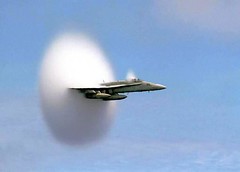
Some of you know that I am a bit of an aviation geek. A while ago I posted the above picture on my Flickr pages with the intention of blogging about it. Then I thought that it might be a bit boring and didn’t. But then yesterday I noticed that a whole bunch of people had checked it out and had commented on how cool it was. Some of them had some questions as to exactly what it was. So I am guessing you all might be interested too. No? Well bugger off then and come back tomorrow.
The picture is an award winning photograph of a US Navy F-18 Hornet Fighter Jet, taken off the Coast of Pusan above the Pacific Ocean. The egg shaped cloud of vapour at the tail of the vehicle, which remains formed for only a fraction of a second, is called a Prandtl-Glauert Singularity.
There is much speculation over what causes a P-G Singularity. Many like to believe that it represents the point at which a jet breaks through the sound barrier. However, this is not actually the case.
These types of clouds only ever form for one reason - the air closest to the jet has cooled to the point where water vapour present in the atmosphere is forced to condense. In aviation, air flows around the fuselage and the wings change the temperature and the pressure of moisture in the air. That’s partly the reason why some jets leave cloudy tracks behind them in the sky – the pressure of air at high altitudes combined with the effects of temperature changes created by the aircraft are two of the factors involved in creating a slowly dissipating trail of vapour.
The only reason that planes can actually take off is because of the lift created by differences in air pressure on the top or the bottom of the wings and fuselage. Infact the pressure really varies from point to point in a flow around an object – that’s why you can also see a mini P-G Singularity at the rear of the pilot’s cockpit.
Anyhoo - pretty cool, n’est pas?
No comments:
Post a Comment